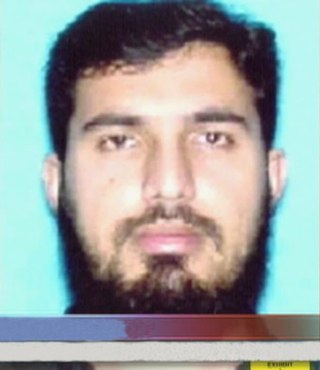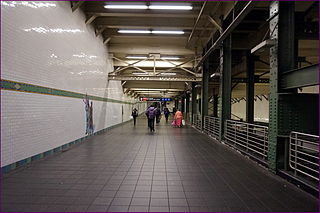Related Research Articles
Saajid Muhammad Badat is a British terrorist who was sentenced to a 13-year prison term for planning to blow up an aircraft with a bomb hidden in his shoe.
The New York City landmark bomb plot was a plan to follow up the February 1993 World Trade Center bombing and was designed to inflict mass casualties on American soil by attacking well-known landmark targets throughout New York City, United States. If the attack had been successful, thousands likely would have died.
Mohammed Junaid Babar is a Pakistani American who, after pleading guilty to terrorist related offences in New York, testified in March 2006 against a group of men accused of plotting 21 July 2005 London bombings. In return for being a government supergrass, his sentence was drastically reduced to time served and he was released leading to widespread criticism in Britain.
Syed Haris Ahmed is a naturalized American citizen born in Pakistan who was convicted on June 9, 2009, of conspiring to provide material support to terrorism in the United States and abroad. His trial was a bench trial. He was sentenced in 2009 to 13 years in prison, to be followed by 30 years of supervised release. At the time of his arrest, he was an undergraduate at the Georgia Institute of Technology, majoring in mechanical engineering.
The 2006 Ontario terrorism case refers to the plotting of a series of attacks against targets in Southern Ontario, Canada, and the June 2, 2006 counter-terrorism raids in and around the Greater Toronto Area that resulted in the arrest of 14 adults and 4 youths . These individuals have been characterized as having been inspired by al-Qaeda.
Osama Eldawoody is a US citizen with a self-proclaimed nuclear engineering degree who has worked as a paid New York City Police Department informant to work undercover in Mosques in the New York metropolitan area. In 2004, his work broke up a terrorist plot by Shahawar Matin Siraj and James Elshafay to blow up the 34th Street–Herald Square station of the New York City Subway, and the Macy's Herald Square Department Store, one of the largest in the world. However, in both instances, his methodology were reported to include entrapping the potential "terrorists" with aggressive and misleading tactics. Some have claimed he created the terrorist plots himself to entrap young and vulnerable people in order to get the FBI and NYPD payments and recognition, and that there weren't any credible terrorist threats to begin with.
Eric McDavid is an American green anarchist who was convicted of conspiring to use fire or explosives to damage corporate and government property and sentenced to 20 years in prison. While U.S. Attorney McGregor W. Scott has called McDavid the first person in the U.S. to be prosecuted on Earth Liberation Front (ELF)-related charges, the trial revealed that McDavid's group had not decided whether or not to claim the planned actions in the name of the ELF. On January 8, 2015, after he spent eight years and 360 days in prison, McDavid's conviction was overturned after the prosecution conceded that the Federal Bureau of Investigation (FBI) had withheld thousands of pages of potentially exculpatory evidence.

In the United States, a common definition of terrorism is the systematic or threatened use of violence in order to create a general climate of fear to intimidate a population or government and thereby effect political, religious, or ideological change. This article serves as a list and a compilation of acts of terrorism, attempts to commit acts of terrorism, and other such items which pertain to terrorist activities which are engaged in by non-state actors or spies who are acting in the interests of state actors or persons who are acting without the approval of foreign governments within the domestic borders of the United States.

On May 20, 2009, US law enforcement arrested four men in connection with a fake plot concocted by a Federal Bureau of Investigation (FBI) informant to shoot down military airplanes flying out of an Air National Guard base in Newburgh, New York, and blow up two synagogues in the Riverdale community of the Bronx using weapons supplied by the FBI. The group was led by Shahed Hussain, a Pakistani criminal who was working for the FBI to avoid deportation for having defrauded the New York State Department of Motor Vehicles. Hussain has never been charged in the United States with any terrorism related offenses and was paid nearly US$100,000 by the FBI for his work on this plot.
Bryant Neal Vinas is a Hispanic Muslim American convicted of participating in and supporting al-Qaeda plots in Afghanistan and the U.S.
The 2009 New York City Subway and United Kingdom plot was a plan to bomb the New York City Subway as well as a target in the United Kingdom.

Najibullah Zazi is an Afghan-American who was arrested in September 2009 as part of the 2009 U.S. al Qaeda group accused of planning suicide bombings on the New York City Subway system, and who pleaded guilty as have two other defendants. U.S. prosecutors said Saleh al-Somali, al-Qaeda's head of external operations, and Rashid Rauf, an al-Qaeda operative, ordered the attack. Both were later killed in drone attacks.
Revolution Muslim (RM) was an organization based in New York City that advocated the establishment of a traditionalist Islamic state through the removal of the current rulers in Muslim-majority nations and an end to what they consider "Western imperialism". It was founded in 2007 by two American Muslim men: Jesse Curtis Morton and Yousef Al-Khattab.
The 2010 Portland car bomb plot involved an incident in which Mohamed Osman Mohamud, a Somali-American student, was arrested in an FBI sting operation on November 26, 2010, after attempting to set off what he thought was a car bomb at a Christmas tree lighting in Portland, Oregon. He was charged with attempting to use a weapon of mass destruction. An attorney for Mohamud argued that his client was entrapped. On January 31, 2013, a jury found Mohamud guilty of the single charge against him. He was scheduled to be sentenced on December 18, 2013, however the sentencing was cancelled in anticipation of the filing of new motions by the defense. In September 2014, Mohamud was sentenced to 30 years in federal prison with credit for time served, as well as lifetime supervision upon release in 2040.
Ralph Kenneth Deleon is a Filipino, and legal permanent resident of the United States, who in 2015 was convicted of conspiracy to commit murder of members of the United States military and government, and providing material support for terrorists. Deleon is serving a 25-year sentence.
On July 31, 1997, officers from the NYPD Emergency Service Unit raided an apartment in Brooklyn, New York City, after being warned of a planned bombing. Gazi Ibrahim Abu Mezer and Lafi Khalil, both Palestinian illegal immigrants were shot and apprehended during the raid, which located two pipe bombs in the apartment.

On December 11, 2017, a pipe bomb partially detonated in the subway station adjoining the Port Authority Bus Terminal in Midtown Manhattan, New York City, injuring four people including the bomber. Mayor Bill de Blasio described the incident as "an attempted terrorist attack". The bomber was identified by police as 27-year-old Akayed Ullah, a Salafi Muslim immigrant from Bangladesh; he was convicted in 2018 and sentenced to life in prison in 2021.
Abdulrahman El Bahnasawy is a mentally ill Canadian citizen who was convicted of terrorism-related offenses in 2016. El Bahnasawy plotted to carry out, via online chatting, an attack on Times Square in New York City and to also attack the subway system. In December 2018, El Bahnasawy was sentenced to 40 years in federal prison under intensive solitary confinement despite his serious mental illness.
References
- ↑ Bomber's family is detained The New York Sun
- ↑ Kelly fears terror within New York Daily News
- ↑
- "Band of brothers.(United States v. Shahawar Matin Siraj)" . Harper's Magazine . October 1, 2006. Retrieved August 24, 2014– via HighBeam Research.
- "Terror Informant Seeks Sen. Clinton Help" . Associated Press . September 13, 2006. Retrieved August 24, 2014– via HighBeam Research.
- Shulman, Robin (May 29, 2007). "The Informer: Behind the Scenes, or Setting the Stage?" . The Washington Post . Retrieved August 24, 2014– via HighBeam Research.
- Hays, Tom (September 14, 2006). "Letter to Clinton may affect terrorism case" . The Buffalo News . Retrieved August 24, 2014– via HighBeam Research.
- "Would-Be NYC Subway Bomber Faces Prison" . Associated Press . January 7, 2007. Retrieved August 24, 2014– via HighBeam Research.
- Hays, Tom (May 25, 2006). "Pakistani immigrant guilty in subway bomb plot" . Associated Press . Retrieved August 24, 2014– via HighBeam Research.
- "Would-Be NY Subway Bomber Gets 30 Years" . Associated Press . January 9, 2007. Retrieved August 24, 2014– via HighBeam Research.
- Rashbaum, William K. (May 26, 2006). "Pakistani is convicted in N.Y. subway bomb plot" . International Herald Tribune . Retrieved August 24, 2014– via HighBeam Research.
- Wolff, Carlo (December 16, 2007). "A hard look at the state of American justice" . Chicago Sun-Times . Retrieved August 24, 2014– via HighBeam Research.
- Pipes, Daniel (September 16, 2011). "New York's anti-terror example" . Chicago Jewish Star . Retrieved August 24, 2014– via HighBeam Research.
- ↑ "Man Gets 30 Years in Subway Bomb Plot". The New York Times . 9 January 2007. Retrieved 24 February 2011.
- ↑ The Herald Square Bomber Who Wasn’t The New York Times, 15 April 2021.
- 1 2 3 Shulman, Robin (29 May 2007). "The Informer: Behind the Scenes, or Setting the Stage?". Washington Post . Retrieved 5 February 2020.
- 1 2 Rashbaum, William (28 May 2006). "Window Opens On City Tactics Among Muslims: Getting a Conviction, And Causing Concern". New York Times.
- ↑ Vitale, Alex S. (2017). The End of Policing . Verso Books. p. 212. ISBN 9781784782894.
- ↑ Lee, Jennifer. "Entrapment Evidence Lacking, Jurors Say." The New York Times, May 25, 2006 pB7
- ↑ Guilty verdict in plot to bomb subway station The New York Times
- ↑ One and done is likely for Islam mole CAGE Archived October 26, 2007, at the Wayback Machine
- ↑ Undercover officer testifies in 2004 bomb plot case Rantburg
- ↑ Convicted subway bomb plotter's family released NY1 News
- ↑ DATA & GRAPHICS: Population Of The Communications Management Units, Margot Williams and Alyson Hurt, NPR, 3-3-11, retrieved 2011 03 04 from npr.org